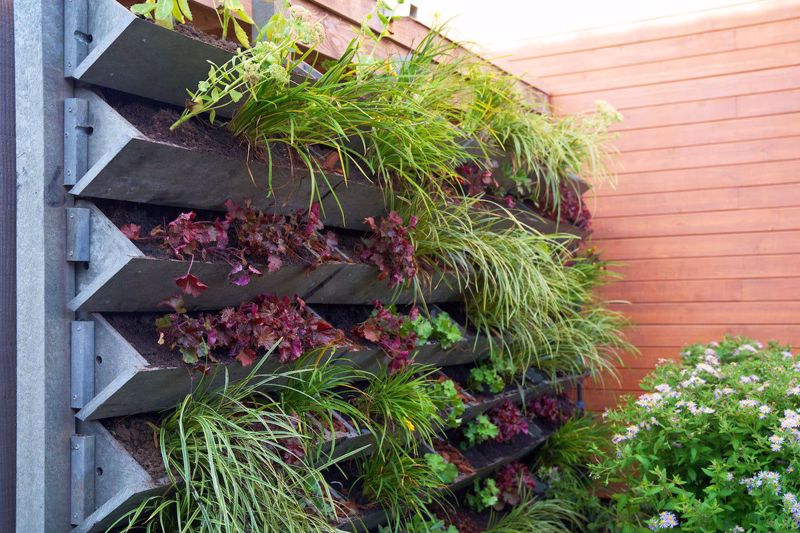Vertical gardens, also known as living walls or green walls, are a fantastic way to maximize your gardening space, improve air quality, and enhance the aesthetic appeal of your home. Whether you have a small balcony, limited yard space, or simply want to bring more greenery indoors, vertical gardens offer a practical and visually stunning solution. In this article, we will guide you through the step-by-step process of building and growing a vertical garden in the United States. From selecting the right location and materials to choosing suitable plants and providing proper care, you'll discover all you need to know to create a thriving vertical garden. With a Home Depot Money Saving Coupon from We Are Coupons you can save money on creating a vertical garden.
Choose the Ideal Location
The first step in building a successful vertical garden is selecting the right location. Consider factors such as sunlight exposure, accessibility for watering and maintenance, and the weight-bearing capacity of the chosen wall or structure. Determine whether you prefer an outdoor or indoor vertical garden and assess the available space accordingly.
Select the Right Structure and Materials
Next, decide on the structure and materials for your vertical garden. There are various options, including modular systems, pocket planters, trellises, and repurposed materials such as pallets or gutters. Ensure that the chosen structure is sturdy, provides adequate support for the weight of the plants and growing medium, and allows for proper drainage.
Prepare the Wall or Structure
Before installing your vertical garden, prepare the wall or structure. Clean the surface, repair any damages, and apply a waterproof barrier if necessary. This step is crucial to protect the wall and ensure the longevity of your vertical garden.
Choose Suitable Plants
Selecting the right plants is essential for the success of your vertical garden. Consider factors such as light requirements, plant size, and growth habit. Opt for plants that thrive in your specific United States region and climate. Herbs, succulents, ferns, and trailing vines are excellent choices for vertical gardens due to their adaptability and attractive growth patterns.
Prepare the Growing Medium
Prepare a suitable growing medium for your vertical garden. A lightweight, well-draining soil mix or soilless medium is recommended to prevent waterlogged roots. Incorporate organic matter or compost to enhance fertility and moisture retention. Ensure that the chosen medium is appropriate for the selected plants and the specific requirements of a vertical growing environment.
Install and Plant
Carefully install the structure and prepare it for planting. Follow the manufacturer's instructions or the chosen DIY method to securely attach the structure to the wall. Fill the planters or pockets with the prepared growing medium and gently insert the plants, taking care not to damage the roots. Consider the desired arrangement and spacing to ensure proper growth and aesthetics.
Provide Proper Care
Maintaining your vertical garden is crucial for its long-term success. Regularly water the plants, ensuring that the entire vertical garden is adequately hydrated. Pay attention to the specific water needs of each plant, adjusting your watering schedule accordingly. Fertilize the plants regularly using a balanced, water-soluble fertilizer to promote healthy growth.
Monitor and Maintain
Monitor your vertical garden for any signs of pests, diseases, or nutrient deficiencies. Inspect the plants regularly and address any issues promptly to prevent them from spreading. Prune or trim the plants as needed to maintain their shape and prevent overcrowding. Regularly check the irrigation system, if applicable, to ensure proper functioning and prevent clogging.
Enjoy the Benefits
As your vertical garden flourishes, you'll reap numerous benefits. Enjoy the beauty and tranquility of a green wall, improve air quality, and create a unique focal point in your space. Harvest fresh herbs, vegetables, or fruits from your vertical garden, adding a delightful and sustainable element to your culinary endeavors.
Conclusion
Building and growing a vertical garden in the United States is an excellent way to maximize your gardening space, beautify your environment, and connect with nature. With careful planning, suitable plant selection, and proper maintenance, your vertical garden will thrive, regardless of whether it's an outdoor feature or an indoor accent. Embrace the beauty and functionality of vertical gardening and elevate your gardening experience to new heights. Start creating your own stunning vertical garden today and enjoy the benefits it brings to your home and the environment.




